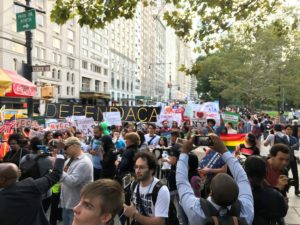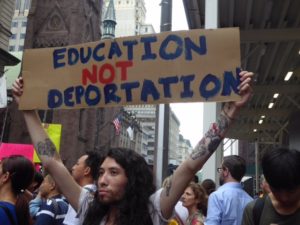by Anne Jaclard
Protests are in full force across the U.S. against Trump’s latest racist, harmful action: he is ending protection from deportation for 800,000 young immigrants who were brought illegally to the U.S. as children. For the past five years, those who qualified and registered have been safe from deportation under the DACA program put into place by President Obama. (DACA stands for Deferred Action for Childhood Arrivals.) DACA was enacted after a long campaign by young undocumented immigrants who called themselves “Dreamers” because they dared to dream of coming out of hiding and being able to attend college, hold jobs and live like other people in the U.S.
A recent poll showed that 76% of the country favors the continuation of DACA. It is now up to Congress to enact a law that allows the Dreamers to remain, and to do so before the end of the six-month delay in Trump’s termination of DACA.
Since yesterday’s announcement to end DACA, protesters have amassed in Washington, D.C., New York, Los Angeles, San Francisco, Phoenix, Albuquerque, Nashville, Louisville, Sacramento, and more cities. High school students walked out in Denver and elsewhere. Dreamers have begun hunger strikes. And this is certainly just the beginning.
Cristina Jimenez of the huge advocacy group United We Dream said defiantly, “We are outraged. My brother is in DACA, enabling him to work and help support the family. I myself was undocumented for 10 years. We are not going back into the shadows!”
The protesters vow to keep fighting “for justice.” Many keep speaking out publicly, showing their faces and saying their names—in spite of the government having their names and addresses, their fingerprints, and all kinds of information about them and their families, schools and jobs. In six months’ time, they can easily be picked up and deported if they are thrown into the deportation pipeline. I wonder how many Americans would risk being exiled to a place they don’t even know, instead of going back into hiding in the shadows.
Dreamers in the Resistance
Dreamers have been prominent in the Resistance since Trump took office, speaking out at rallies and marches against the Muslim travel ban, the proposed wall on the border with Mexico, and the many other attacks on civil liberties and human rights, as well as fighting to save DACA. It is heart-breaking to hear them describe the struggles their families went through to flee violence and poverty in Mexico and elsewhere in Central America and around the world, and then having to live underground lives of constant fear in the U.S.
As part of his anti-immigrant rhetoric during the presidential campaign, Trump had vowed to eliminate DACA “on day one” of his presidency. He carried out his promise yesterday––in spite of public sentiment in favor of DACA––with the backing of the white supremacists in the White House and among his base supporters. This man claimed the other day that he “loves the DACAs” and that he has “great heart,” but he is terminating the program, eliminating renewals in six months for those enrolled and closing new registrations now. Former President Obama called the termination “wrong and cruel,” as have many business leaders and government officials.
What DACA Meant
Beginning around 2000, the Dreamers conducted extensive campaigns, protests, and civil disobedience to bring attention to the plight of undocumented youth–who never chose to enter the country illegally. The movement began among students in Florida with a long march from Florida to Washington, and spread quickly among Latinos across the country. They appealed to Americans to allow them to remain in what for most is the only country they have ever known (DACA recipients came here before the age of 16) and to keep their families intact. A 2011 article describes the development of their amazing grass-roots movement.
At the time, I thought they would never win because they could only appeal to humanitarian sentiment, not to financial interests. Yet over the years, some Democrats in Congress tried to legalize them, introducing the first Dreamers bill in 2001. It almost became law in 2010 when it passed the House but not the Senate. Obama finally got up his nerve and enacted it by executive decree in 2012. The legality of its implementation is not clear; it has not been ruled on directly by the courts.
To qualify for DACA, one had to be enrolled in school, have a job or be in the military, and have an unblemished criminal record, pay a fee, and re-qualify every two years. In spite of DACA lacking any path to permanent-residence status, let alone citizenship, it provided hope to remain permanently and some stability in the lives of the young people and their families.
It is estimated that an additional one million youth and young adults could have qualified to enroll in DACA, but decided not to do so. They were undoubtedly afraid to try to register, fearing disclosure of their status could lead to immediate deportation. DACA recipients have been exemplary residents, working hard to stay in school and get good jobs, paying taxes while being barred from federal government benefits, helping their parents to survive. They are backed by many big businesspeople who don’t want to lose them as employees. Law-enforcement agencies also support DACA, because they need the cooperation of immigrants to fight crime, while undocumented people are afraid to call or cooperate with the police.
Is There Hope for DACA?
Trump is shifting the onus onto Congress by providing for the six-month delay so that Congress can pass legislation to enact DACA, or perhaps even to overhaul immigration law. The latter is unlikely– immigration law hasn’t been substantially reformed in the past 30 years due to the competing interests of nativist ideologues and businesses that need immigrant labor.
Stop-gap laws have occasionally been passed to meet certain interests, such as allowing in Filipino nurses when there was a critical nursing shortage some years ago. And agriculture has benefited for many decades from special programs allowing Mexicans to enter the U.S. seasonally to do farm work, such as the infamously exploitative Bracero programs. But the U.S. has rarely granted amnesties to undocumented people to become “legal” in any numbers. And restricting immigration is a paramount demand of Trump’s racist, xenophobic base of support.
Trump had his notoriously racist and anti-immigrant Attorney General Jeff Sessions make the announcement that DACA is ending. Sessions went into a long explanation of the supposed economic reasons that DACA was bad. The speech was one lie after another, since these young people contribute more to the economy than they take out, and there are too few of them to have any effect on the U.S. unemployment rate. And Sessions emphasized the “illegality” of Obama’s implementation of DACA, saying that only Congress can make immigration policy. This is pretty “funny,” inasmuch as Session’s Justice Department defended Trump’s Muslim travel bans on the grounds that the President had the absolute authority to make immigration decisions.
Republicans in Congress will undoubtedly maneuver to tie enactment of a DACA law to funding Trump’s wall on the border with Mexico, which Congress has so far refused to fund, and to at least some changes in current immigration law. Trump backs the RAISE bill, which would drastically reduce the overall yearly number of legal immigrants, grant most applications on the basis of high job skills while refusing more applications for family members of current U.S. residents, and eliminate the “lottery” that granted entry to some people from under-represented countries. Trump was threatening to cause a government shutdown if he didn’t get his wall; then the disastrous Hurricane Harvey in Texas made a shut-down particularly unpalatable; then he proposed to take a billion dollars of the disaster relief funds to pay for the wall, but that didn’t fly—so now he needs some other form of blackmail to get his wall. It seems doubtful that he will ever get the wall, but what damage he is doing along the way! Dreamer activists said today that they will oppose any bill to fund the wall, even if it is coupled with restoring DACA.
Americans keep hoping that Congress will stand up to Trump, but the only people we can count on now are the very active Resistance and the immigrants’ supporters in the larger population.
Photos are of demonstrations in support of DACA in New York City, taken for MHI on August 15 and September 4, 2017.






Anne, thank you for this illuminating article…it does highlight the depth and political agility of the anti-Trump resistance.
One parallel DACA has with the UK is that after the Grenfell tower fire, in London, in June 2017, the media, as part of finding dirt on the survivors, took to insinuating that many of them deserved little help or sympathy because of their potentially illegal status.
Also, because a number of them may well be undocumented, when the issue was raised as part of a campaign for them to get justice, our Home Office agreed that they would not be deported if they stepped forward to give evidence. But that amnesty is for less than a year, so of course, the reluctance of many of the survivors persists.